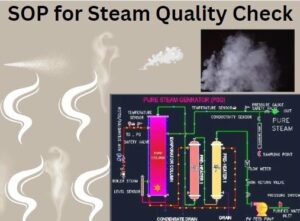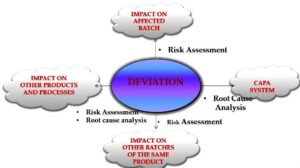The objective of this Standard Operating Procedure for Steam Quality Check is to outline the steps and guidelines for conducting a steam quality check to ensure that the steam generated meets the required quality standards for various industrial processes.
SOP for Steam Quality Check
- OBJECTIVE:
- To lay down the Procedure for the steam quality check .
- SCOPE:
- This SOP is applicable for Steam Quality Check.
- RESPONSIBILITY:
- Technician/ Operator of Engineering Department shall be responsible for proper execution of operation as per SOP of steam quality check.
- Engineering – Head/Designee shall be responsible for reviewing the SOP and for ensuring proper execution as per SOP of steam quality check.
- ACCOUNTABILITY:
- Engineering – Head shall be accountable for proper implementation of the SOP of steam quality check.
- DEFINITIONS:
- NIL
- PROCEDURE:
- NON-CONDENSABLE GAS TEST in steam quality check:
- Non-condensable gases (NCGs) are defined as gases which cannot be liquefied by compression under the range of conditions of temperature and pressure used during the sterilization process. The main source of NCGs in the steam supply is the feed-water & the level will be greatly influenced by the water treatment employed.
- This test is intended to show that the amount of non-condensable gases in the steam will not prevent the load from being sterilised under any condition.
- The apparatus used to check the non- condensable gases limit & the method of testing is as per the HTM 2010 guideline Part 3.
- The instrument used in this apparatus are as follows:
- Steam Service Pipe.
- 50 ml burette with inbuilt funnel.
- 2000 ml container with overflow vent at a 1500 ml.
- Steam sample delivery SS coil & a silicon pipe of 6mm O/D.
- Needle valve with a ¼ Inch vent pipe welded with TC.
- 250 ml measuring cylinder.
- Burette stand.
- Suction Bulb.
- Digital temp. meter along with sensor.
- Needle/Diaphragm valve to remove the condensate.
- Testing Procedure: in steam quality check
- Refer the drawing of “Non Condensable gas Test” for assembling of the apparatus.
- Connect the needle valve to the steam service pipe.
- Assemble the apparatus so that condensate will drain freely from the silicon tube fitted on the vertical mounted needle valve into the sampling coil.
- Fill the 2000ml container with PW of 26 to 27°c, until it overflows from the overflow port attached to the container at 1500ml.
- Open the valve provided on the burette & pull the water with the suction bulb from the container into the burette.
- Add some more water into the container so that it again overflows.
- Turn on the incoming steam line so that it passes through the service pipe. Along with it crack open the needle/Diaphragm valve connected at the end of this service pipe.
- Crack open the vertical needle valve & allow the air to be removed from the sampling coil. Ensure that the total air from the sampling coil is removed then, shut off the needle valve.
- During this course there is possibility that the water level in the burette will drop down.
- Pull the water again in the burette as done in step no 6.2.5 and 6.2.6
- Open the vertical mounted needle valve slowly till little bit hammering of the sampling coil is observed.
- Wait for few seconds & then note the water level in the burette.
- Put the temperature sensor in the container & observe the temperature in the meter.
- Wait till the temperature in the container reaches 80-85°C.
- Shut OFF the needle valve.
- Note the volume of gas collected in the burette (Vb) and the volume of the water collected in the measuring cylinder (Vc).
- Calculation:
- Fraction of non- condensable gases are calculated as follows:
- % of NCGs = 100 X (Vb/Vc)
- Where Vb = Volume of water displaced from the burette.
- Vc = Volume of water collected in the measuring cylinder.
- Accepted limit of NCGs% = NMT 3.5%
- SUPER HEAT TEST:
- Refer the drawing of “Super Heat Test” for assembling of the apparatus.
- The test requires a pitot tube as per the drawing attached.
- Fit the pitot tube concentrically within the steam service pipe.
- Drain the condensate from the steam line if any and shut off the valve.
- Insert the expansion tube to the other end of the pitot tube.
- Insert the temperature sensor through the gland fitted on the expansion tube.
- Ensure that the sensor is in the center of the expansion tube.
- Fix the needle /Diaphragm valve to the other end of the service pipe.
- Drain the condensate from the steam line if any and shut off the valve.
- Pass the steam through the expansion tube for 4-5min & note down the temperature (Te).
- Calculation:
- The super heat can be calculated from the equation:
- Superheat (°C) = Te – To
- Where, Te = Temperature of steam in expansion tube.
- To = Boiling point of water at local atmospheric pressure.
- Accepted limit of superheat = NMT 25°C
- DRYNESS TEST:
- The instruments used in the apparatus are as follows:
- Measuring cylinder.
- Needle valve.
- Vacuum flask (1 ltr) with related arrangement.
- TC fitting pitot tube
- 6MM OD silicon tube.
- Digital temp. Meter along with temperature sensors.
- A laboratory balance capable of weighing a load up to 2Kg with accuracy of 0.1g or better.
- Testing Procedure in the steam quality check:
- Refer the drawing of “Dryness Test” for assembling of the apparatus.
- Fit the Pitot tube concentrically within the steam service pipe as per the drawing attached.
- Fit the sensor entry gland to the steam service pipe. Insert a temperature sensor through the gland and position it on the axis of the pipe.
- Connect the silicon rubber tube to the pitot tube.
- Weigh the flask along with the rubber stopper & SS tube fitted on the rubber stopper, weigh the flask and record the mass (M1).
- Remove the rubber stopper and pour 600-650 ml of cold water (below 27°C) into the flask. Reinsert the rubber stopper on the flask and weigh the flask and record the mass (M2).
- Insert the second sensor through the shorter of the two pipes in the stopper so as to dip in the water in the flask. Note the temperature of the water in the flask (To).
- Pass the steam through the service pipe.
- Let the condensate pass through the tube into the flask.
- Note down the temperature in the service pipe (Ts).
- Note down the temperature in the flask (T1). Let the temperature in the flask rise upto 80°C.
- Disconnect the flask from the rubber tube. Remove the sensor from the flask.
- Weigh the flask containing water plus condensate (M3). Note the weight.
- Do the calculation as mentioned below.
- Connect the other end of the tube coming from the pitot tube to the flask.
Calculation : In steam quality check
The dryness value can be calculated from the following equation:
D= (T1-T0) [CPW (M2-M1)+ A] _ (Ts- T1) CPW
L (M3-M2) L
Where,
L : The latent heat of dry saturated steam at temp. at Ts.
M1 : The mass of the Flask and rubber bung in kg.
M2 : The mass of the Flask and rubber bung, water charge in kg.
M3 : The mass of the Flask and rubber bung, water charge and condensate in kg.
T0 : The initial temperature of the water and the flask in degree Celsius(°C)
T1 : The final temp of the water and condensate in the flask in degree Celsius (°C)
Ts : The temperature of dry saturated steam delivered to the sterilizer, in degree Celsius (°C)
CPW : The specific heat of water (4.187 KJ/Kg)
D : The dryness value of the steam.
A : The effective heat capacity of the apparatus (0.24 kJ/kg).
Mw : The initial mass of water in the flask (kg). Mw = M2 – M1.
Mc : The mass of condensate collected (Kg). Mc = M3 – M2
- Accepted limit of dryness = NLT 0.90 for porous loads
- NLT 0.95 for metal loads
- ABBREVIATIONS
- °C : Degree Centigrade
- % : Percentage
- Ltr : Liter
- NMT : Not More Than
- NLT : Not Less Than
- Kg : kilogram
- kJ : kilojoules
- PW : Purified water
- REFERENCES
- User Manual
- DISTRIBUTION LIST
- SOP shall be distributed to following departments Quality Assurance, Engineering as per user request.
- ANNEXURES
- Steam Quality Check : SOP/EN/XXXYYY STEAM QUALITY CHECK
Test Name: Non-Condensable Gas test in the TEAM QUALITY CHECK.
| Equipment Name: | Test Date: | ||
| Equipment I.D: | Test Location: |
Volume of gasses displaced from the burette (Vb) =
Volume of condensate collected in the measuring cylinder(Vc) =
Fraction of NCGs = 100 X (Vb/Vc)
= 100 X (________/_______)
*Accepted limit of NCGs% = NMT 3.5%
You may also read about Good Laboratory Practices (GLP)



